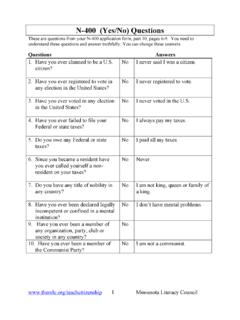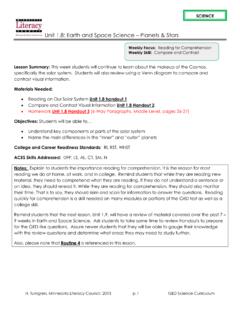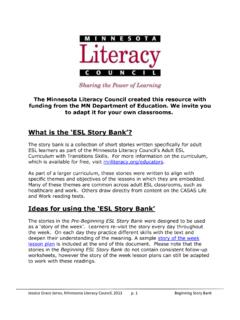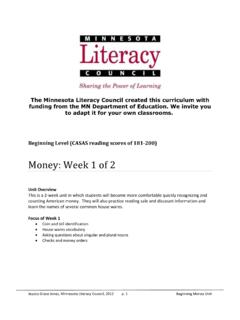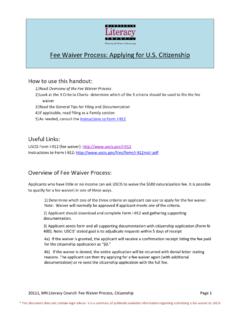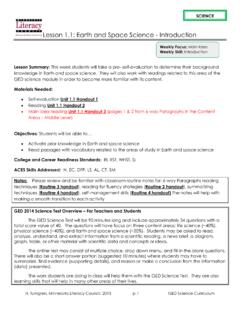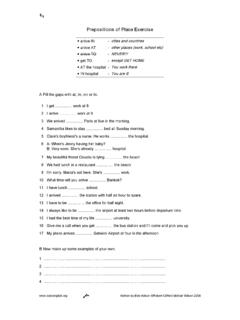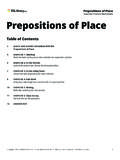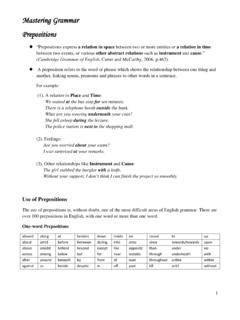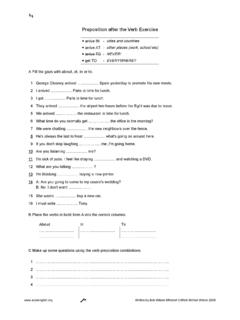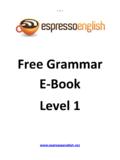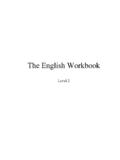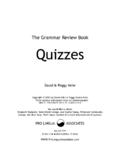Transcription of The Short Essay: Week 2 - Minnesota Literacy Council
1 The Minnesota Literacy Council created this curriculum. We invite you to adapt it for your own classrooms. Advanced Level (CASAS reading scores of 221-235). The Short Essay: Week 2. Unit Overview This is a 6-week unit in which learners produce a variety of genres of Short essays . Advanced learners transition from paragraph writing to Short essay writing. Learners explore unity and coherence in a paragraph and choosing controlled topic sentences. Learners also explore different grammatical points per essay genre. Learners work on avoiding run-on sentences and creating compound sentences with proper conjunctions. Focus of Week 1. Identifying and planning descriptive organization Culinary Arts and Nutrition Choosing appropriate adjectives in descriptive writing Similes and simile structure Using prepositional phrases to give more details in descriptive writing Nikki Carson-Padilla, Minnesota Literacy Council , 2014 p.
2 1 The Short Essay Unit Short Essay Unit: Week 2, Monday Objectives Learners will be able to Materials Literacy : identify characteristics of a descriptive Short essay. Make Student Copies Literacy : free-write for ten to fifteen minutes using Textbook: Effective Academic Writing 2:The Short characteristics of descriptive writing. Essay, pp. 28-31, 38-39. Listening/speaking: orally describe a picture of produce and personal experiences buying produce. Retell a classmate's Make Single Copies or Reference description of a food place using sensory words. Handout: Guava Visual Aid (to be projected w/p. 29). Transitions & Critical Thinking: answer critical thinking questions about How to Eat a Guava by Esmeralda Props, Technology, or Other Resources Santiago, such as: How do you think the author felt ?
3 A projector and, What do you think the author means when ? . Grammar: define prepositional phrase and use some prepositional phrases of location, time, direction, and manner to add more detail to sentences. Lesson Plan Warm up: Thinking about the Topic: Listening/speaking Description: Look at the picture on p. 28 of the text and discuss the questions in part A with a partner. Then answer part B. Form small groups and retell others what partners shared about a specific place using sensory words and reported speech. Materials/Prep: Textbook: Effective Academic Writing 2: The Short Essay, Activity 1: Literacy & Transitions/Critical Thinking Description: Introduce descriptive Short essay and practice identifying the characteristics of descriptive writing.
4 Learners read a prologue entitled How to Eat a Guava with potentially new vocabulary foot-noted. Materials/Prep: Textbook: Effective Academic Writing 2: The Short Essay, pp. 29-30 Handout: Guava Visual Aid (single copy to be projected), and a projector Activity 2: Grammar Description: Read about prepositional phrases and their functions. Complete an exercise inserting appropriate prepositional phrases into sentences in order to add more detail. Materials/Prep: Textbook: Effective Academic Writing 2: The Short Essay, pp. 38-39 (Exercise 3 only on p. 39). Checking for Understanding Description: Free-write for ten to fifteen minutes choosing from the food-related topics provided.
5 Learners express their thoughts and feelings, using sensory words and details whenever appropriate. Materials/Prep: Textbook: Effective Academic Writing 2: The Short Essay, p. 31. Nikki Carson-Padilla, Minnesota Literacy Council , 2014 p. 2 The Short Essay Unit Teacher Directions: Warm Up: What do you smell? What do you taste?-Materials: Textbook: Effective Academic Writing 2: The Short Essay, p. 28. A thesaurus is an excellent resource for expanding one's vocabulary. It is a book full of synonyms and antonyms. A. thesaurus works well to introduce new vocabulary and informs readers and writers which words are similar and Step 1: Setting the Context which are different.
6 However, a Descriptive writing uses words to build images for the reader. These thesaurus rarely shares all the images may come from sights, sounds, smells, tastes, or even feelings. possible connotations of new Good descriptive writing makes the reader feel as if he or she is present in vocabulary, so it is difficult to the scene, p. 28 know whether or not it is appropriate to use a synonym in Words that describe sights, sounds, smells, tastes, and touch are a new situation, especially if one has never heard the word sensory words. Sensory words are usually adjectives that provide before. For example, the seeds the reader with a fuller picture, or sense, of the experience of the tightly embedded in the flesh.
7 Writer. Not every type of sensory word is appropriate in all taken from How to Eat a Guava circumstances; for example, if a writer is describing a person, would most likely not be animal, or place, it may not be appropriate to use taste descriptors. paraphrased to the kernels On the other hand, some taste descriptors can be used forcefully implanted in the idiomatically, such as bitter and sweet, and these will often be meat! For this reason, it is advisable to use a thesaurus used to describe people. with caution and to ask native speakers before using new Step 2: Group Work words (those that the writer has Pairs take approximately 10 minutes to discuss the questions under never encountered before).
8 Part A of Exercise 1 on p. 28. Then, ask partners to move on to independently thinking about part B. Depending on class size, learners may remain in pairs, or they may regroup by joining another pair, creating a small group of four. Share ideas about part B for an additional 5-10 minutes. Step 3: Report Out Groups share their descriptions with the whole class. Ask a learner or two from each group to share some of the sensory words used by their group members. Learners should use reported speech and retell what a classmate shared during the earlier discussion of part B. This holds all learners accountable for the listening/speaking objective and also allows learners to think about sensory words used by others.
9 Nikki Carson-Padilla, Minnesota Literacy Council , 2014 p. 3 The Short Essay Unit Teacher Directions: Activity 1: Literacy /Transitions & Critical Thinking-Materials: Effective Academic Writing 2: The Short Essay, pp. 29-30; Handout: Guava Visual Aid (single copy to be projected), and a projector Step 1: Context Sometimes one particular experience can create a memory that stays with us for many years. The following reading describes Esmeralda Santiago's memories of the guavas she ate as a child, Learners read an excerpt from a longer text that is full of descriptive language. The goal of reading How to Eat a Guava is not to learn the process of eating guava, as the title might insinuate, but rather to help learners identify characteristics of good descriptive writing.
10 Learners should consider what the order, or organization, of the writing is as well as what kind of language provides the details. Before reading, discuss the potentially new vocabulary bolded throughout the text and defined below the margin (like footnotes, minus the numbering system). There are nine terms defined for learners. Project the accompanying handout Guava Visual Aid. Use these visuals as an extended guide for potentially new vocabulary. Step 2: Reading Instructor reads How to Eat a Guava aloud to the class, demonstrating pronunciation of new vocabulary as well as minding punctuation. Learners follow the text as the instructor reads. Learners re-read How to Eat a Guava aloud in pairs.
